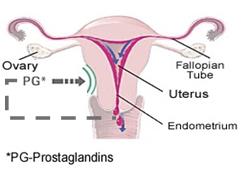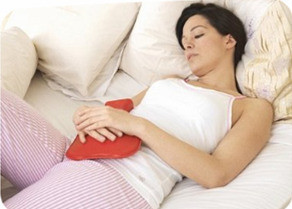Up to 70% of women in their late teens and early 20s may experience incapacitating painful periods (dysmenorrhea). Up to half of these women are unable to perform daily activities or attend work or school due to the pain experienced during their periods.
 Menstrual Cramps are caused by overproduction of (and possibly a heightened sensitivity to) a locally acting hormone prostaglandin F2a made by the inner uterine lining. This stimulates uterine muscle contractions that interrupt blood flow, and consequently pain. Therefore, reducing prostaglandin production can lessen menstrual pain. Alternatively drugs that decrease uterine muscle activity are also effective, but side effects limit their clinical usefulness.
Menstrual Cramps are caused by overproduction of (and possibly a heightened sensitivity to) a locally acting hormone prostaglandin F2a made by the inner uterine lining. This stimulates uterine muscle contractions that interrupt blood flow, and consequently pain. Therefore, reducing prostaglandin production can lessen menstrual pain. Alternatively drugs that decrease uterine muscle activity are also effective, but side effects limit their clinical usefulness.
Medications like ibuprofen (Motirn®, Advil®) or Alleve® inhibit the production and action of prostaglandins. To optimally block prostaglandin production, these drugs should be used as early as possible—even before the intensity of pain justifies medication. Start taking these drugs at the first sign of menstruation, whether that is cramps or bleeding, and to continue to take medication on schedule for the number of days you historically experience disabling cramps (eg. Ibuprofen 600mg—3 OTC 200mg tablets—every 6 hours). Take with food to avoid stomach irritation.
If you still experience pain then see your gynecologist. Hormonal contraceptives (oral contraceptives, depo-Provera®, Nexplanon implants®, Mirena IUD®) contain progestins, which suppress ovulation and also counter estrogen’s growth effect on the inner uterine lining. Since there is less uterine tissue less prostaglandins are produced, which makes these medications another option to treat painful periods. As an added benefit, hormonal contraceptives also cause lighter and shorter periods. Oral contraceptives can also be used for extended cycles, for instance where menstruation occurs every 3 months to decrease the frequency of unpleasant periods. Breakthrough spotting is common with this approach and though it decreases with continued use, it is the main reason women discontinue this form of treatment.
If you still experience painful periods after trying the above medications, then visit a gynecologist to evaluate for other possible causes. The likelihood of other pelvic pathology is high in these women. One study of 100 women with pelvic pain who did not have adequate pain relief from medical therapy found that approximately 80% had documented endometriosis at laparoscopy. Fibroids and Adenomyosis may also be causes.
Finally, non‑medical remedies, such as cardiovascular exercise, magnesium supplementation and applying a heating pad to the lower abdomen, may also be effective. I hope this information guides you so you may continue to enjoy your usual activities during your periods.
Wishing you good health!
Scott Kramer MD, FACOG
Share this newsletter with those you care… sisters, mothers, friends











Speak Your Mind